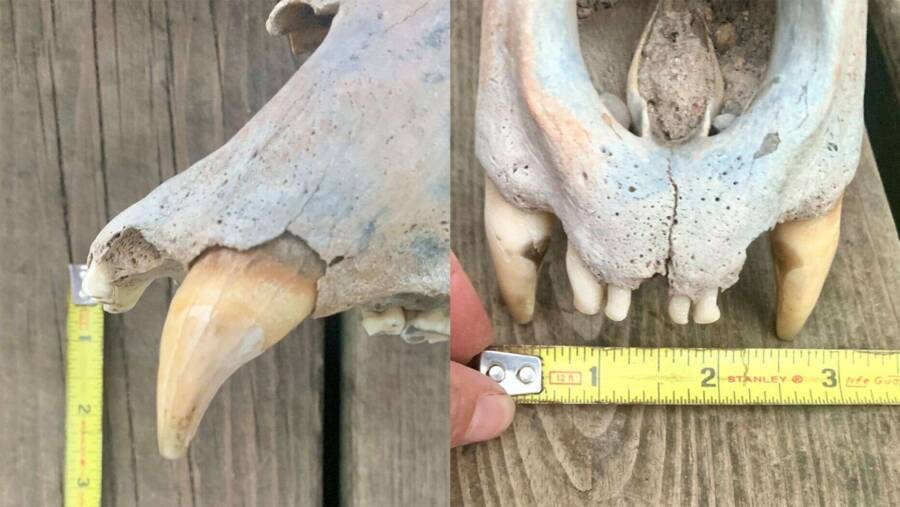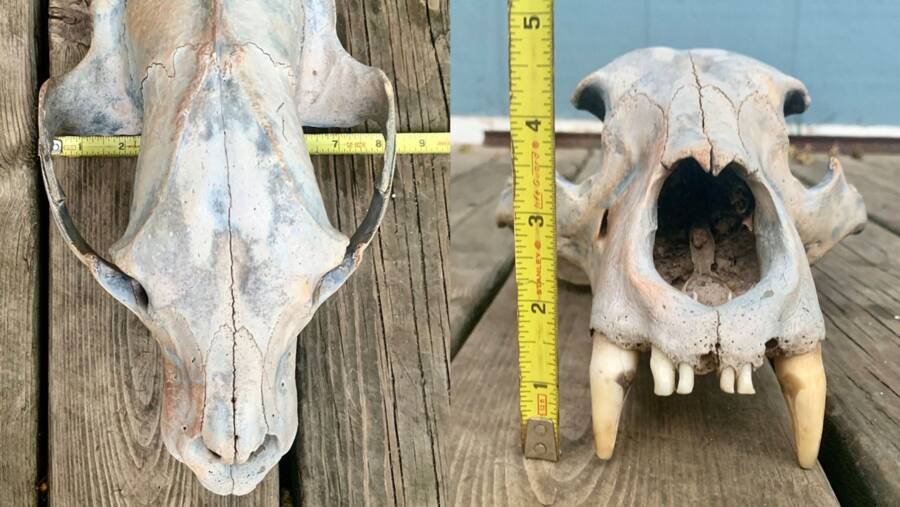Only three grizzly bear skulls of this kind have ever been found in Kansas, the last of which was discovered in the 1950s. The siblings donated their rare find to the Sternberg Museum.

Kansas Department of Wildlife, Parks and TourismThe bear skull measured 16 inches long and 8.5 inches wide. It’s one of only three skulls of its kind discovered in Kansas — the last of which was found in the 1950s.
Ashley and Erin Watt were kayaking the Arkansas River like any other adventurous pair of siblings would do. Unlike your typical boat ride, however, this one ended with an ancient grizzly bear skull in their possession.
According to a press release from the Kansas Department of Wildlife, Parks & Tourism (KDWPT), the discovery began when the two sisters saw a large skull sticking out of a sandbar. The skull was later measured to be 16 inches long and 8.5 inches wide.
Once they pulled the bone out, it was obvious this once belonged to a carnivorous predator — its large teeth a glaring clue.
After an enthusiastic Facebook post from the sisters, KDWPT’s game warden Chris Stout shared the social media photos with his colleagues.
According to Fox News, word of this remarkable find quickly spread to Sternberg Museum of Natural History paleontologists Dr. Reese Barrick and Mike Everhart, who were quite impressed.
“[The grizzly skull] is one of three skulls of its type found in Kansas last of which was found in the 50’s,” an updated Facebook post from the sisters read.
“It is also the most complete of the three. The bear probably died of old age, not to [sic] far from where we found it, because it would not have been in the excellent condition it is if it had traveled far on the river.”
Due to its fossilized state, the experts were confused whether or not this belonged to a modern grizzly or a more ancient counterpart.
“The bear skull was washed out of the same river sediments that routinely produce the skulls and bones of the American bison, some of which could date back as far as the last Ice Age,” said Everhart.

Kansas Department of Wildlife, Parks and TourismAshley and Erin Watt were kayaking when they saw the skull protruding from a sandbank. Thanks to social media, experts were able to get in touch and analyze the find.
As coincidence would have it, Ashley is a former high school agriculture teacher, while her sister Erin studies animal science at West Texas A&M University. The sisters’ Facebook post confirmed that scientists dated their find to be at least over 200 years old.
“Whether it is hundreds or thousands of years old, the skull gives us a better insight into the richness of life on the plains before Western man.”
The most plausible theory currently posits the skull was buried in the Ark River sands, which are highly conducive to longterm preservation, before it was displaced by the historic floods earlier this year.
Although grizzly bears are native to Kansas, the KDWPT believes this particular species had been extirpated by the mid-1800s. That historical likelihood leads some to believe this fossil did, indeed, belong to the more modern variant of the animal. The skull is certainly in pristine condition, save for a few minor teeth being absent.
“It’s been pretty amazing not only discovering the skull but also the crowdsourcing used to determine how truly exceptional this find is,” said Ashley. “We can’t wait to see what further information can be uncovered about this incredible animal.”
In the spirit of shared experience, the two sisters generously donated the skull to the Sternberg Museum.
After learning about the ancient bear skull discovered by two sisters kayaking in Kansas, read about the reconstructions from ancient skulls revealing what humans looked like 9,500 years ago. Then, learn about evidence of the fabled “king” polar bears potentially being discovered in Alaska.





